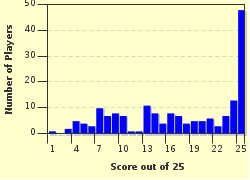Quiz Answer Key and Fun Facts
1. Where did Mailer grow up?
2. Mailer started college in 1939 at the tender age of sixteen. Where did he go to college?
3. Mailer spent his college years writing as much as he could. However, he did not major in a writing-related field. What was his main field of study in college?
4. After graduating from college in 1943, Mailer entered the army, and his army years provided the material for his 1948 bestselling novel, "The Naked and the Dead". Where did Mailer serve while in the army?
5. Mailer first became politically active during the 1948 U.S. presidential campaign. Who did he support?
6. Mailer was personally never harassed by the House Un-American Activities Committee during the McCarthy era, but someone in his family was. Who was this?
7. Mailer and his first wife Bea separated in 1951, and Mailer moved into a loft in Greenwich Village with his eventual second wife, Adele, a loft which he renovated himself. What memorable event happened at a party in 1951 at his new apartment?
8. While living with Adele in New York, Mailer went out one night to walk their two poodles, and got into a fight with a sailor. What did the sailor do to instigate this fight?
9. In 1955 Mailer was part of a small group which started the alternative newspaper, "The Village Voice", but he left the paper the following year. What led to his leaving?
10. The early 1950's was not a good time for Mailer, as neither of the two new novels he published was very well received. Things started looking up with "The White Negro" in 1957, and then in 1959 he came out with a book with a more personal and journalistic style, a style which he was to maintain for the rest of his life. What was this 1959 book called?
11. In 1960 Mailer was hired to write a magazine piece about John F Kennedy, who was then running for president. Which magazine published his piece, called "Superman Comes to the Supermart"?
12. In November of 1960, two weeks after the presidential election, an event which altered Mailer's life forever happened at a party he threw to explore a run for mayor of New York. What happened?
13. In the months following the incident in November of 1960, what sort of writing did Mailer mainly do?
14. Mailer had always been fascinated by boxing, and in 1962 he wrote a piece for "Esquire" called "Ten Thousand Words a Minute", about the heavyweight championship fight between Sonny Liston and Floyd Patterson. However, in that piece he also wrote about a welterweight fighter who was killed as a result of a fight. Who was this unfortunate welterweight?
15. A highlight of Mailer's career was his 1968 book "The Armies of the Night", which won a Pulitzer Prize. What was this book about?
16. In the late 1960's Mailer became fascinated with cinema and made three movies. Which is *not* one of his three films?
17. During the filming of his third movie, Mailer was attacked with a hammer. Who attacked him?
18. In 1969 Mailer ran for mayor of New York. Who was his running mate?
19. What was the cornerstone of Mailer's platform when he ran for mayor of New York in 1969?
20. "Of a Fire on the Moon", about the United States space program, was published in 1970 as Mailer's twelfth book. However, it was originally published as a three-part series in which magazine?
21. In 1980 Mailer won a second Pulitzer Prize, this time for "The Executioner's Song", a book about the life and execution of Gary Gilmore, who in 1977 became the first person executed in the United States after the reinstatement of the death penalty the previous year. In which state was he executed?
22. In 1993 Mailer spent six months in Russia. What was he doing there?
23. On December 4, 1971, Mailer made a memorable appearance on "The Dick Cavett Show", an appearance which nobody lucky enough to have witnessed will ever forget. What was Mailer so mad at Gore Vidal about on that show?
24. At one point in the famous Dick Cavett show with Gore Vidal in December of 1971, after much verbal sparring Cavett says, "Let me turn my chair and join these people. Perhaps you'd like two more chairs to contain your giant intellect." Mailer replied, "I'll take the two chairs if you will all accept ________." What goes in the blank?
25. How many times was Mailer married?
Source: Author
chessart
This quiz was reviewed by FunTrivia editor
bloomsby before going online.
Any errors found in FunTrivia content are routinely corrected through our feedback system.

